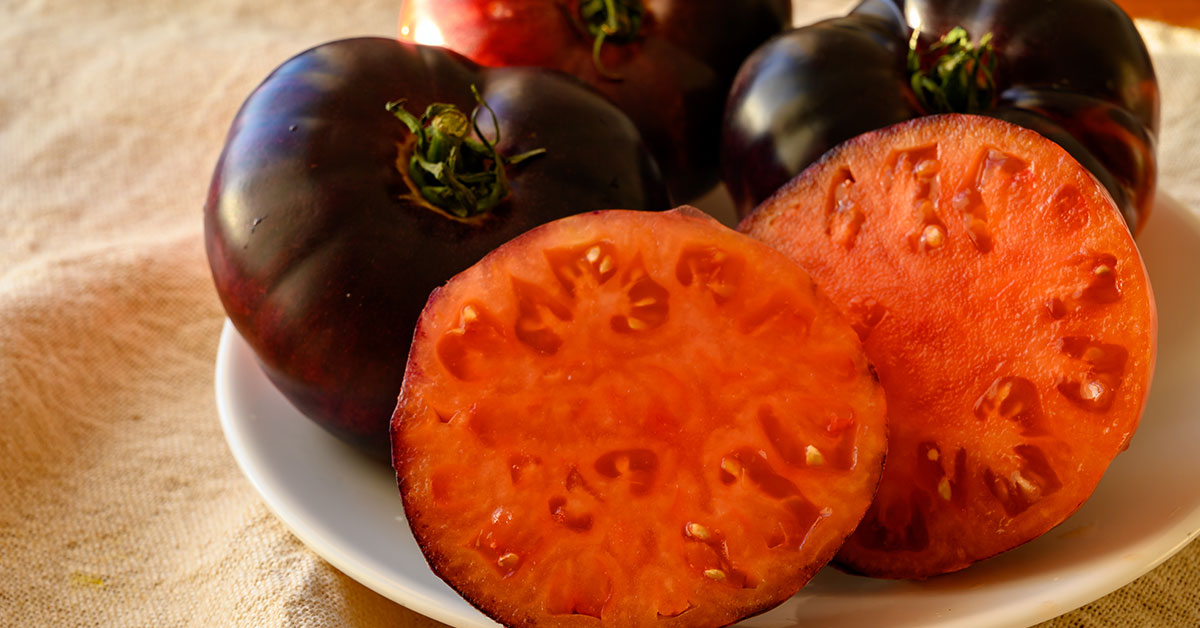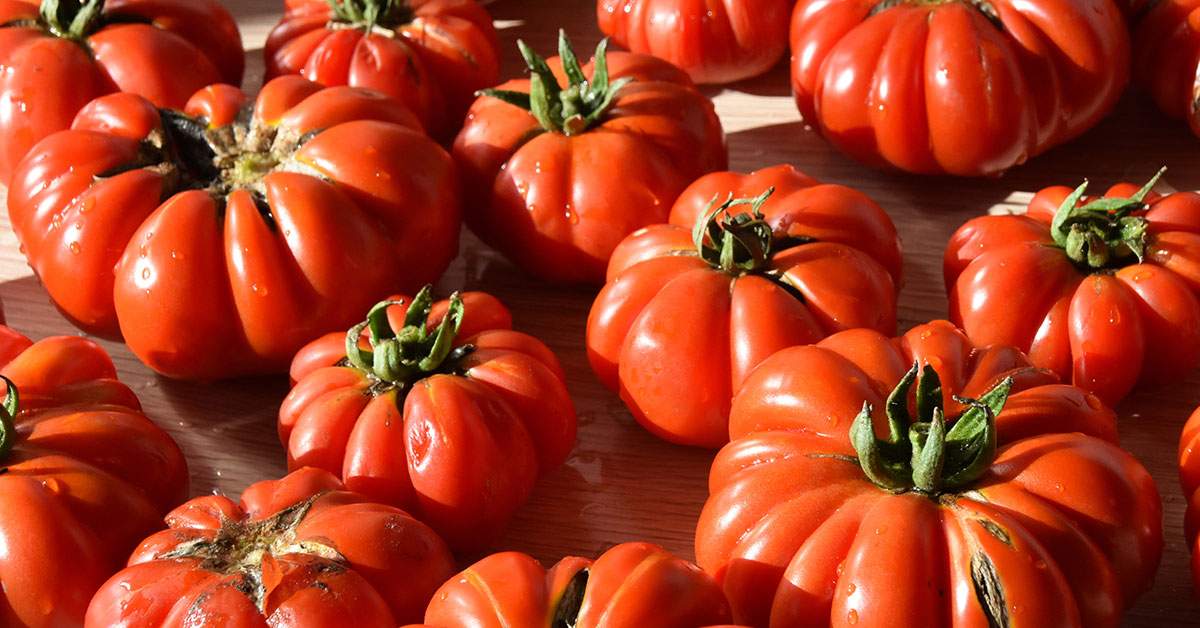The Purple Calabash tomato is a unique and fascinating variety of tomato that is gaining popularity among home gardeners and chefs alike. With its distinctive deep purple color and unusual shape, this tomato is not only beautiful but also packed with flavor and nutrition.
In this blog post, we will explore the history, characteristics, and benefits of the Purple Calabash tomato and how you can grow and use this remarkable fruit in your own kitchen.
What is a Purple Calabash tomato?
The Purple Calabash tomato is a unique variety of tomato that is gaining popularity among gardeners and food enthusiasts alike. This heirloom tomato variety is known for its distinctive shape, color, and flavor.
The Purple Calabash tomato is a beefsteak tomato that is typically small to medium-sized with a flattened and slightly ribbed shape. What sets this tomato apart is its striking deep purple color, which is not commonly found in other tomato varieties. The fruit has a creamy, sweet flavor with a slightly tart finish, making it a perfect addition to salads, sandwiches, and other dishes.
This tomato variety originated in South America and was brought to the United States by early settlers. Over time, it has become a favorite among gardeners who appreciate its unique appearance and delicious taste. The Purple Calabash tomato is also known for its hardiness and disease-resistant qualities, making it a popular choice for home gardeners.
Whether you are a seasoned gardener or a food lover looking to try something new, the Purple Calabash tomato is a must-try. This beautiful and flavorful tomato variety is sure to impress, and its unique qualities are sure to make it a conversation starter at your next family gathering or dinner party.
How to start Purple Calabash tomato seeds
Starting tomatoes from seed is a cost-effective and rewarding way to grow your own tomato plants. To begin, choose the tomato varieties that suit your preferences and growing conditions.
Fill seed trays or pots with a lightweight and well-draining seed starting mix, plant the seeds at the recommended depth, and provide adequate moisture and warmth for germination.
Once the seedlings have developed their second set of true leaves, they can be transplanted into larger containers or individual pots. Gradually acclimate the seedlings to outdoor conditions before transplanting them into the garden.
By following these basic steps, you can successfully start tomatoes from seed and enjoy a thriving crop of homegrown tomatoes.
Additional Resource: Our comprehensive guide to starting tomatoes from seed
Growing & care
Transplanting and caring for tomatoes outdoors involves a few essential steps. First, choose a sunny location with well-drained soil. Prior to transplanting, harden off the seedlings by gradually exposing them to outdoor conditions.
Dig a hole slightly larger than the root ball of each seedling and plant them, burying the stem up to the first set of leaves. Water the seedlings thoroughly after transplanting. Provide consistent watering, aiming for 1-2 inches of water per week.
Stake or cage the plants for support and prune indeterminate varieties by removing suckers. Monitor for pests and diseases, taking prompt action if necessary. By following these steps, you’ll set your tomato plants up for healthy growth and a fruitful harvest.
Additional Resource: How to transplant and care for tomatoes outdoors
Common tomato pests and diseases
Tomatoes are susceptible to various pests and diseases that can affect their health and productivity. Some common tomato pests include aphids, tomato hornworms, whiteflies, and cutworms. These pests can cause damage to leaves, stems, and fruit, leading to reduced plant vigor and yield.
Additionally, tomato plants can be affected by diseases such as early blight, late blight, fusarium wilt, and verticillium wilt. These diseases can cause leaf discoloration, wilting, and fruit rot. Proper identification and timely intervention are crucial to effectively manage these pests and diseases and ensure the successful growth of tomato plants.
Additional Resource: Comprehensive list of tomato diseases and pests and how to fix them
Common problems
Purple Calabash tomato is a unique variety of tomato that is known for its rich purple color and sweet, tangy flavor. However, like any other plant, it is susceptible to certain problems during the growing process. Here are some common problems you may encounter when growing Purple Calabash tomato and how to address them:
- Poor Soil Quality: The soil quality is crucial for growing healthy and sturdy Purple Calabash tomato plants. If the soil is too sandy or too clayey, it can affect the plant’s growth and development. To address this issue, you can amend the soil by adding compost or organic matter to improve its texture and fertility.
- Pests: Pests such as aphids, whiteflies, and tomato hornworms can cause damage to the leaves and fruits of the Purple Calabash tomato plant. You can control these pests by using natural methods such as releasing ladybugs or lacewings, spraying neem oil, or using insecticidal soap.
- Diseases: Diseases such as fungal infections and blight can cause wilting, yellowing, and premature death of the plant. To prevent these diseases, ensure that the plants are spaced out properly to allow for adequate airflow and avoid overhead watering. Additionally, you can use fungicides or organic solutions such as garlic spray to control fungal infections.
- Environmental Stress: Environmental stressors such as extreme heat or cold, drought, or excess moisture can affect the growth and yield of the Purple Calabash tomato plant. To address this issue, ensure that the plant is receiving adequate water and is not exposed to extreme temperatures. Additionally, you can apply mulch around the base of the plant to conserve moisture and regulate soil temperature.
By being aware of these common problems and taking appropriate measures to address them, you can ensure a healthy and fruitful harvest of Purple Calabash tomato.
Uses for Purple Calabash tomato
Purple Calabash tomato is a unique variety of tomato that has a distinctive shape and color. This heirloom tomato is known for its rich, complex flavor that is both sweet and tangy. While Purple Calabash tomatoes are often used in salads and sandwiches, they are also used for a variety of other purposes.
One of the most common uses for Purple Calabash tomatoes is for making sauces and salsas. Their rich flavor and meaty texture make them ideal for creating flavorful and hearty sauces that can be used for pasta dishes, pizzas, and more. They are also a great addition to homemade salsas, adding both flavor and texture to the dish.
Another popular use for Purple Calabash tomatoes is for roasting and grilling. Because of their thick skin and flesh, they hold up well to the high heat of the grill or oven. Roasting or grilling them brings out their natural sweetness and intensifies their flavor, making them a great addition to a variety of dishes.
In addition to sauces and roasting, Purple Calabash tomatoes can also be used for canning and preserving. Their firm texture and rich flavor make them ideal for canning whole or for making tomato sauces and pastes that can be stored for later use.
Overall, Purple Calabash tomatoes are a versatile and flavorful variety of tomato that can be used in a variety of dishes. Whether you are making sauces, roasting, or canning, these unique tomatoes are sure to add a delicious and complex flavor to your recipes.













